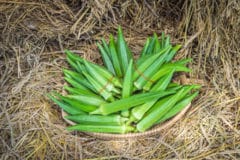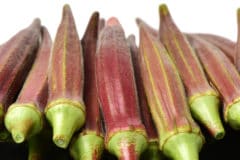First, You Need to Harvest Some Okra
The first okra pods will appear five to six days after your okra flowers, and they will grow to 2 to 3 inches long and be ready to harvest within two to three days. Because the pods develop so quickly, they can mature and become too tough to eat in just a few days, so you need to check your okra plants for pods to harvest at least every two days.
Harvesting Okra
Whenever you search your okra for pods to harvest, you should wear gloves and a long-sleeved top because the spines can irritate your skin. Use pruning shears or a knife and cut the stem just above the cap at the top of the pod.
If the stem has become difficult to cut, the pod will have become woody and too difficult to eat. Remove the pod anyway, because leaving mature pods will cause the okra plant to begin focusing on developing mature seeds rather than on producing pods. Generally, though, any pod under 5 or 6 inches should still be tender enough to eat, although the shorter pods are more tender.
When you are harvesting your okra, you can let the pods low on the plant fall to the ground. Okra bruises easily, though, so try to catch the pods that are growing higher on the plant, and put them in a basket.
What’s Next?
What you do next depends on whether you want to store the okra you harvested or whether you harvested it to use right away.
Storing Okra
You can store okra for a few days, less than a week, in your refrigerator. The humidity should be between 90 and 95 percent, and the temperature should remain between 45°F and 50°F (7°C-10°C).
For long term storage, you can put your okra into plastic bags and freeze it whole, blanch it and freeze it whole or in slices, or can or pickle it.
Preparing Fresh Okra for Cooking
To prepare fresh okra for cooking:
- Use a paring knife to cut around the base of the cap and remove it without cutting into the pod.
- Remove the spines from older, larger pods by holding the pod under running water as you gently rub its surface with a vegetable brush, some paper towel, or a nylon scourer.
- Dry your okra before cooking by patting it with a dishtowel and then spreading it out and leaving it to air dry.
As already mentioned, the liquid inside of okra pods thickens gumbo, and it can do the same for casseroles, stews, and other dishes. To use it as a thickener, blanch the whole okra and then wait to slice the okra so that you can add it just when your dish has 10 minutes left to cook.
There are several ways to reduce the amount of liquid okra releases when you aren’t using it as a thickener. You can leave the okra whole; freeze it whole and slice it while it’s still frozen; soak the okra for a half hour, using 1/2 cup of vinegar for every 1 pound of okra, and then let it dry before cooking it; or blanch, roast, sauté, or grill the okra before adding it to your dish.












